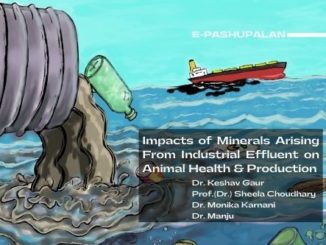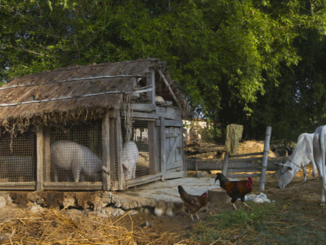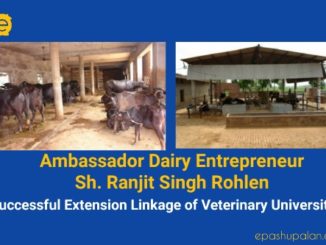India is a country with varied agro climatic conditions. While some parts of India has comfortable weather during summer, the other parts experience extreme temperature During 2018, most parts of India, experienced a heat wave and the condition further deteriorated in 2019 with Rajasthan peaking at 50.80C. Further, the high temperature coupled with humidity aggravates the situation. During such circumstances, it becomes extremely difficult for all living beings to cope up with these hot weather conditions. Poultry too is no exception and rearing poultry in intense summer becomes highly challenging.
There are about one million animal species of which only 20,000 species are homeothermic, majority of the species bred by man are homeotherms. Poultry being homeotherms are able to maintain their internal body temperature within certain limits. Homeostatic mechanisms regulating body heat production and body heat loss allow keeping the body core temperature relatively constant. No additional energy is required to dissipate or create heat when birds are in the thermoneutral zone (130C to 240C). Either side of this is critical zone (240C-380C and 0-130C). Temperature beyond this at either side of this zone is detrimental. Birds primarily dissipate heat by conduction, convection and radiation. However, birds resort to panting beyond 280C. If heat production becomes greater than ‘maximum heat loss’ either in intensity (acute heat stress) or over long periods (chronic heat stress), it leads to heat prostration and death. Due to panting, CO2 excretion increases and shortage of carbonates (CO3) occur resulting in a higher pH value of the blood. Mineral secretion in the urine goes up creating a shortage of these minerals. Further, more corticosterone is produced
The ideal temperature for broiler production is within the range of 120C to 280C. Broilers grow better at lower side of the range and have better feed efficiency at higher sides of the range. During heat stress, there is reduced growth rate, feed consumption, poor feed efficiency, nutrient deficiency and acid base imbalance or respiratory alkalosis. Mortality is high at temperature beyond 380C and relative humidity above 50%, the ideal temperature for layers is 15-250C. During heat stress in layers, there is reduced feed consumption, egg production, egg size, poor shell quality, poor fertility and hatchability.
Nutritional strategies
- High energy diet: High energy diet with supplemental lysine and methionine improves performance. Use of carbohydrates to increase energy is not recommended as heat increment is more in carbohydrates than fat. Dietary energy in broiler diet may be increased by 2 to 3% at the cost of carbohydrates without changing ME. Fats are good in summer because their heat increment value is lowest give better cooling effect in body because of higher water content and fat stimulates feed consumption. Fat also decreases the rate of passage of feed in gastrointestinal tract and increases the efficiency of energy digestion which is otherwise known as extra calorific effect.
- Increasing nutrient density: With the onset of summer, feed should be made denser with nutrients, vitamins and minerals to compensate for reduced intake. Energy density of the diet is increased by 200 kcal/kg diet for each 50C rise in temperature beyond thermoneutral zone.
- Modulation of dietary protein: Protein level in feed should not be increased and protein from only vegetable source should be used. Proteins in general and those from animal sources in particular have higher heat increment.
Vegetable proteins (Soya, Sesame, Sun flower) are rich in arginine. Under heat stress arginine absorption are low and so results in plasma amino acid imbalance, leading to increased catabolism of amino acids adding to body heat. Hence, vegetable proteins are preferred in summer. While keeping protein levels same, crucial amino acids may be increased to compensate for reduced feed intake. During heat stress, low protein diet below 20% with supplemental methionine and lysine is beneficial in broilers. - Limiting feeding time: Feed should be withdrawn from 9am to 4.30 pm.: This is very effective in reducing mortality associated with heat stress. Feed intake and digestion produce nearly 7% additional heat in the body which is maximum 4 to 5 hours after feed intake. This should not coincide with hottest part of the day (2 to 3 pm). Birds fasted during day compensate intake in the night time and it should be seen that lights do not go off at night.
- Supplementation of vitamins and minerals: During heat stress, availability of vitamins is decreased. Vitamin requirement is increased in birds during heat stress. In addition the metabolic activity is also increased. Breeder birds require about three times more vitamin A at 380C as compared to 250 During heat stress, conversion of vitamin D3 to its active form required for calcium metabolism is adversely affected. The synthesis rate of vitamin C is decreased in birds during heat stress. Excessive panting causes dehydration and results in loss of carbon dioxide leading to acid base imbalance. Encouraging birds for water consumption can reduce heat stress. Thus, during moderate hot weather, supplementation of ascorbic acid 62.5 mg/litre, acetylsalicylic acid 62.5 mg/litre, sodium bi carbonate 75 mg/litre and potassium chloride 125 mg/litre is recommended. During heat stress, supplementation of vit C 400 mg/ L, acetyl salicylic acid (disprin 1 tablet/5 L), sodium bicarbonate 1gr/Litre is recommended. Optimum responses in production indices may occur with supplementation of 250,g vitamin C/ diet in broilers and 250-400 mg/ kg diet in layers. 0.17% sodium bicarbonate in diet or 0.06% in drinking water may elicit production indices in broilers. Further, supplementation of 0.5% sodium bicarbonate in diet or 0.15% in drinking may improve egg shell quality in layers.
- Antioxidants: During heat stress, there is excessive oxidative metabolism and release of free radicals in the body. Free radicals damage all types of biological molecules and cells.VitE captures and neutralizes free radicals and its inclusion at 50 to 100 ppm in feed is advisable. Vitamin C also has antioxidant property. Similarly antioxidants namely BHA, BHT and EQ protect fats and oils in feed from oxidative rancidity. Polyphenols are better anti-oxidants than vitamin E and vitamin C and helps in regenerating the oxidized vitamin E.
- Betaine: During heat stress, the osmolarity of cell is affected, when there is excessive loss of water and electrolytes from the bird’s body. Thus, the cell integrity and function is lost resulting in poor growth. Betaine is an organic osmolyte. So, supplementation of betaine through feed/ water has been beneficial.
|
The content of the articles are accurate and true to the best of the author’s knowledge. It is not meant to substitute for diagnosis, prognosis, treatment, prescription, or formal and individualized advice from a veterinary medical professional. Animals exhibiting signs and symptoms of distress should be seen by a veterinarian immediately. |






1 Trackback / Pingback